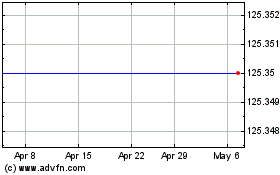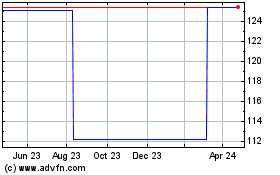Rio Tinto Annual Net Profit Up 22%, to Pay Special Dividend
17 February 2021 - 5:13PM
Dow Jones News
By Rhiannon Hoyle
SYDNEY--Rio Tinto PLC unveiled a surprise special dividend after
a sustained rally by iron-ore prices drove a 22% rise in annual net
profit.
Rio Tinto, the world's second-biggest mining company by market
value, on Wednesday reported a net profit of $9.77 billion for
2020. That compared to a profit of $8.01 billion in 2019.
The bottom line included $1.3 billion of exchange losses and
$1.1 billion in impairment charges, mostly against three of its
Pacific Aluminium smelters, its ISAL smelter in Iceland and its
stake in the Diavik diamond mine in Canada's Northwest
Territories.
Riding tailwinds from a surge in iron-ore prices, Rio Tinto
reported a 20% lift in underlying earnings to $12.45 billion. That
was above expectations of a $11.75 billion underlying profit,
according to a compilation of 16 analyst forecasts published by
Vuma.
Rio Tinto runs one of the world's biggest iron-ore export hubs
and the commodity, used to make steel, accounts for the bulk of its
earnings.
Directors declared a final dividend of $3.09 a share, taking the
miner's full-year ordinary payout to $4.64 a share. Last year, Rio
Tinto paid $4.43 a share, and analysts had been forecasting a total
dividend of $4.80, according to the Vuma-compiled consensus.
Rio Tinto said it would also pay a special dividend worth $0.93
a share in what was the first financial result under new CEO and
former chief financial officer Jakob Stausholm.
"During 2020, the agility and resilience of the business and our
employees, coupled with strong commodity prices, enabled us to
deliver underlying Ebitda of $23.9 billion and return on capital
employed of 27%," said Mr. Stausholm.
The special dividend confounded expectations of many analysts
who had predicted Rio Tinto would act cautiously on capital
management as it battles to contain the fallout from the
destruction of two ancient rock shelters in Australia's
minerals-rich Pilbara region last year.
The disaster cost former Chief Executive Jean-Sébastien Jacques
his job amid a global backlash from investors, communities and
lawmakers who demanded executives be held accountable for the
destruction of the caves at Juukan Gorge on May 24.
While Rio Tinto says it is committed to talks with the
traditional indigenous owners of the land it mines, it has also
been lifting iron-ore production and is benefiting from a surge in
prices for the commodity, which in December struck a nine-year
high.
The benchmark price for the commodity jumped as high as $176.90
a metric ton late in 2020 on strong Chinese demand, which was
underpinned by China's quicker-than-anticipated economic recovery
from the Covid-19 pandemic.
Rio Tinto in January said it produced 2% more iron ore in
Australia last year versus 2019, with mines here--which account for
most of its iron-ore production--largely unaffected by the
coronavirus pandemic as Australia enjoyed relative success in
keeping its spread under control.
Write to Rhiannon Hoyle at rhiannon.hoyle@wsj.com
(END) Dow Jones Newswires
February 17, 2021 00:58 ET (05:58 GMT)
Copyright (c) 2021 Dow Jones & Company, Inc.
Rio Tinto (ASX:RIOCD)
Historical Stock Chart
From Mar 2024 to Apr 2024

Rio Tinto (ASX:RIOCD)
Historical Stock Chart
From Apr 2023 to Apr 2024
